Derek Barton's Blog, page 28
April 6, 2017
A New Land to Behold…
[image error]
Recently I have been toying with the idea of making maps for my fantasy worlds detailed in Consequences Within Chaos, the prequel Seyde in Blood and my upcoming sequel The Bleeding Crown.
There are a lot of debate on whether maps are a hindrance or a benefit to your story. I think that like any other writing tool or technique that a writer can use, it should be considered carefully for each story, thought out thoroughly and done on a case by case basis. Not every story will warrant a map.
The first important question to consider is: will it add to the story for the reader? Do you think that there may be too many names floating about in your prose or do you feel that the layout of your places are pretty straightforward for the reader to follow? When I read George R.R. Martin’s A Song of Ice and Fire, I had to often look at the maps to keep the story straight in my head. For that matter, he had so many characters going all over the place and working with so many different characters, I even made an Excel Spreadsheet to keep the names straight! But Mr. Martin has such a great talent and incredible story that I forgave him as a reader and put in the extra effort.
Another question: Do you feel that the map is going to help you as the writer? Will it guide you in keeping all the facts straight and keeping an accurate idea of where each character might be? Or will a map also give you inspiration or show you where you have room to grow?
When you do decide, you will also face the dilemma of where are you going to get it? Are you going to draw it yourself and if so, do you have the right amount of cartography skill? If you are not taking up the challenge to create it, then what resources do you have to get one? There are a ton of “free map images” out on the net, but then you may have to make concessions or even possibly alterations to your story. Perhaps you might be wise to invest on getting it professional completed. There are also many websites that will provide map-making services or websites like Cartographers Guild that has a forum for questions and/or advice.
Overall, the questions surrounding the “to map or not to map” debate really comes down to time, resources and whether or not it will benefit you as a writer and/or the readers.
For myself, I have started my sequel and I think it will be a positive addition for the readers to see where the lands are and maybe help give the readers a better perspective of all the key lands that are involved in the story. My plan is to make a map of both worlds detailed in the books. And yes, I do plan on designing the maps myself. I designed several in my old Dungeon & Dragon days and found that it really provoked ideas and plots (usually evil plots to mess with the players!! haha)
I will keep you all in the loop and hopefully share my maps soon!!


March 20, 2017
When One Must Battle… — Derek Barton
[image error]
When I started my first novel, Consequences Within Chaos, I fell into an almost obsessive “plot mode” and wrote a rather long, bulleted outline of my story (60 pages to be exact). However, for the battle scenes, I skipped past with a lazy wave of the hand and just wrote a line “insert battle scene here.” Not giving the battle scene its prosper respect was not only a big mistake as far as outlining, but it also became a huge stumbling block for me when I attempted my first drafts.
Why?
Well, when it came time to write these epic battles, I found I had no real idea where to start. Instinctively, I knew that there was a lot riding on capturing this part to my story just right. I had lied to myself and naively thought that this would “all magically be revealed and come naturally to me”.
Suddenly with all that sitting upon my shoulders, I put off writing the first one; even postponed and put aside the book for months. I wouldn’t categorize this period as writers block, but maybe a weird version of stage fright? If I didn’t write the scene (didn’t walk out upon the stage), then I wouldn’t screw it up (I wouldn’t show how bad I was at this) and embarrass myself (fall flat on my face in front of the audience).
It took me a lot of research, experimentation, rewrites and some sheer will to get the battles done for the book. They’re not perfect, but I am happy with them overall. Will I do better nowadays? I sure hope so!
To save you from my pain, here are the critical factors you need to answer when using a battle scene (this includes all types of fights – barroom brawls, ambushes, street assaults and all the way to the epic, five army battles!):
Determine who is all involved (Characters/groups) – this includes not just your main characters or protagonist and any friends, but it includes the antagonist (most times) and/or his minions or allies. Also keep in mind any surprise attendees you may want to include. This will add to the tension of the scene!
Provide goals and personal motivations for all parties (Individual beliefs) – you will need to ask yourself why you are doing this battle. Ask yourself if the battle is really important to the overall story (in other words, don’t include it just to have an action sequence). Also ask what reasons and goals does each character have for the battle. Make them have an invested motive to being there. What do they have to lose being there or what do they need to achieve? Here is a great chance to really highlight a person’s inner thoughts. Showcase their strengths, courage or lack thereof. And be sure that their reasons are not the same for each battle and you are not just repeating what you have already accomplished.
Decide where the battle will take place (Setting) – this important step can elevate your scene to that next level. Backgrounds can be key elements that bring the scene to life. If the battle takes place in a cliché or too common landscape then the scene might come across as redundant or even predictable. For example, look at the epic fight scene between Annakin Skywalker and Obi-Wan Kenobi in Star Wars III: The Revenge of the Sith. The frantic battle between the two characters was incredibly more entertaining due to tension of having their duel upon pieces of debris in a lava flow. The battle was a highlight for this film (as there were very few that I can think of). If the battle was just on a large open field, the scene would not have stuck in your mind. However, use caution as there is a fine line between entertainment and disbelief!
Orchestrate the exact movements and attacks (Pace) – here you must be careful with the “dance steps” of the battle. Who moves where and who reacts to what. It is very important to write the actions carefully so as to not be choppy (which happened with my first attempts) and has to be clear so that the reader isn’t confused. Remember they cannot actually see it and are relying on your words to paint the proper picture. Also in order for the prose to be read smoothly and the pace of the combat to be in line with the action, use short terms, small paragraphs and simpler words. The whole hope is to have the readers become immersed, have their breaths taken away and have them on the edge of their seats trying to figure out what’s going to happen next. If they are reading through intricate details, lengthy descriptions or wordy dialogue, they are not going to experience the same impact that they would with tighter pacing.
Include at least one unexpected event or tactic (Conflict) – as a rule for myself, I try to bring a creative element to the battle that the readers as well as the characters were not expecting. It heightens the tension of the whole scene. In the movie Braveheart, they added often many twists to their battles that caught the viewers and the combatants by surprise. During one battle that comes to mind, when the English were charging on horseback with swords held high and ready to trample the foot soldiers of Wallace’s armies, the Scots suddenly brought up spears that were hidden within the tall grass! While the unfortunate horses paid the price mostly for this trick, this simple twist changed the whole expected outcome.
Plan for and carry out the results (Outcome) – when you start designing the battle, be sure you know what you are getting for each side and be sure you what you really want for your plot and story. Many writers have written themselves into a deep corner because they didn’t think ahead to the outcomes. They focused so much on the battle that they didn’t plan for the results. Your battles should serve you! Whether the results pin your main character down even harder (which is great – the farther the point where the character has to come back from, the more tension and conflict it brings to the story) or whether they actually win at last what they have been struggling to obtain the entire story, battles are stepping stones for your characters. Battle outcomes are pivotal and vital to the future of the story and it can be disastrous to lose focus on that.
Every scene is a platform for your character to level up and grow in the direction you need them to in your story. Their triumphs or losses are the very ingredients that make up who they are. Just like us in every day life – if we don’t experience ups and downs then we do not grow from them or learn from the journey.
Writing a battle scene can place your character under intense scrutiny, pressure to succeed and motivate him or her to excel – without this extreme moment of their life they would not have achieved anything your story wants and needs them to accomplish.
For us as writers, battles are waged and won with swords and words!


When One Must Battle…
[image error]
When I started my first novel, Consequences Within Chaos, I fell into an almost obsessive “plot mode” and wrote a rather long, bulleted outline of my story (60 pages to be exact). However, for the battle scenes, I skipped past with a lazy wave of the hand and just wrote a line “insert battle scene here.” Not giving the battle scene its prosper respect was not only a big mistake as far as outlining, but it also became a huge stumbling block for me when I attempted my first drafts.
Why?
Well, when it came time to write these epic battles, I found I had no real idea where to start. Instinctively, I knew that there was a lot riding on capturing this part to my story just right. I had lied to myself and naively thought that this would “all magically be revealed and come naturally to me”.
Suddenly with all that sitting upon my shoulders, I put off writing the first one; even postponed and put aside the book for months. I wouldn’t categorize this period as writers block, but maybe a weird version of stage fright? If I didn’t write the scene (didn’t walk out upon the stage), then I wouldn’t screw it up (I wouldn’t show how bad I was at this) and embarrass myself (fall flat on my face in front of the audience).
It took me a lot of research, experimentation, rewrites and some sheer will to get the battles done for the book. They’re not perfect, but I am happy with them overall. Will I do better nowadays? I sure hope so!
To save you from my pain, here are the critical factors you need to answer when using a battle scene (this includes all types of fights – barroom brawls, ambushes, street assaults and all the way to the epic, five army battles!):
Determine who is all involved (Characters/groups) – this includes not just your main characters or protagonist and any friends, but it includes the antagonist (most times) and/or his minions or allies. Also keep in mind any surprise attendees you may want to include. This will add to the tension of the scene!
Provide goals and personal motivations for all parties (Individual beliefs) – you will need to ask yourself why you are doing this battle. Ask yourself if the battle is really important to the overall story (in other words, don’t include it just to have an action sequence). Also ask what reasons and goals does each character have for the battle. Make them have an invested motive to being there. What do they have to lose being there or what do they need to achieve? Here is a great chance to really highlight a person’s inner thoughts. Showcase their strengths, courage or lack thereof. And be sure that their reasons are not the same for each battle and you are not just repeating what you have already accomplished.
Decide where the battle will take place (Setting) – this important step can elevate your scene to that next level. Backgrounds can be key elements that bring the scene to life. If the battle takes place in a cliché or too common landscape then the scene might come across as redundant or even predictable. For example, look at the epic fight scene between Annakin Skywalker and Obi-Wan Kenobi in Star Wars III: The Revenge of the Sith. The frantic battle between the two characters was incredibly more entertaining due to tension of having their duel upon pieces of debris in a lava flow. The battle was a highlight for this film (as there were very few that I can think of). If the battle was just on a large open field, the scene would not have stuck in your mind. However, use caution as there is a fine line between entertainment and disbelief!
Orchestrate the exact movements and attacks (Pace) – here you must be careful with the “dance steps” of the battle. Who moves where and who reacts to what. It is very important to write the actions carefully so as to not be choppy (which happened with my first attempts) and has to be clear so that the reader isn’t confused. Remember they cannot actually see it and are relying on your words to paint the proper picture. Also in order for the prose to be read smoothly and the pace of the combat to be in line with the action, use short terms, small paragraphs and simpler words. The whole hope is to have the readers become immersed, have their breaths taken away and have them on the edge of their seats trying to figure out what’s going to happen next. If they are reading through intricate details, lengthy descriptions or wordy dialogue, they are not going to experience the same impact that they would with tighter pacing.
Include at least one unexpected event or tactic (Conflict) – as a rule for myself, I try to bring a creative element to the battle that the readers as well as the characters were not expecting. It heightens the tension of the whole scene. In the movie Braveheart, they added often many twists to their battles that caught the viewers and the combatants by surprise. During one battle that comes to mind, when the English were charging on horseback with swords held high and ready to trample the foot soldiers of Wallace’s armies, the Scots suddenly brought up spears that were hidden within the tall grass! While the unfortunate horses paid the price mostly for this trick, this simple twist changed the whole expected outcome.
Plan for and carry out the results (Outcome) – when you start designing the battle, be sure you know what you are getting for each side and be sure you what you really want for your plot and story. Many writers have written themselves into a deep corner because they didn’t think ahead to the outcomes. They focused so much on the battle that they didn’t plan for the results. Your battles should serve you! Whether the results pin your main character down even harder (which is great – the farther the point where the character has to come back from, the more tension and conflict it brings to the story) or whether they actually win at last what they have been struggling to obtain the entire story, battles are stepping stones for your characters. Battle outcomes are pivotal and vital to the future of the story and it can be disastrous to lose focus on that.
Every scene is a platform for your character to level up and grow in the direction you need them to in your story. Their triumphs or losses are the very ingredients that make up who they are. Just like us in every day life – if we don’t experience ups and downs then we do not grow from them or learn from the journey.
Writing a battle scene can place your character under intense scrutiny, pressure to succeed and motivate him or her to excel – without this extreme moment of their life they would not have achieved anything your story wants and needs them to accomplish.
For us as writers, battles are waged and won with swords and words!


March 7, 2017
New Character Sketch #2… — Derek Barton
Here is another sneak peek at an upcoming character for The Bleeding Crown, sequel to Consequences Within Chaos.
Scars
Character Profile Questions:
What is their name? Only known as Scars. He lost his birth name in battle and will never use the real one again.
How old? 48 years old (He is one of the species called Flohki which live on average to 110 years old. Their upper torso features are mainly bird, the rest humanoid.)
What does your character look like? White feathered head, broken beak, scars running down left cheek and multiple scars along the top and back of his head. He has the muscular body of a weightlifter and the head features of a seagull and icy blue eyes.
Where does he live? During an ambush along the Flohki borders, he was captured and enslaved by a roving Thette Giant Clan. He is the personal slave of Korba-Tarn and bodyguard of the giant’s mate, Frest-Alae.
Where is the character from? Scars grew up in a fishing community called Maxnen Vale. The Flohki continent called Cammiana consists endless grasslands surrounding lush swamps. The Flohki are divided in a civil war with the Pesha-aar due to territory and nesting land disputes. This disorganization has made them very vulnerable to the Quietus Army and the Ebon Throne.
What kind of childhood? Through his first decade of life he was happy and worked hard alongside his older brothers on the docks and the fishing boats. When times got tough and his family had misfortunes (a typhoon destroyed their small fleet of boats and home), the parents were forced to turn there children over to the Elder Leaders of the Ledatd Nest. Conscripted as “Bre-ox-da” which means “battleborn”, he and his brothers learned and trained in military combat. The Bre-ox-da are navy warriors that protect the coast lines. They were expected to serve for life as an “honor”. The Flohki don’t believe in allowing anyone to be homeless, however they do require some form of restitution. The parents would not be able to feed the boys and themselves so the Leaders took the boys and the parents were given shelter and food for their remaining lives.
What does the character do for a living? Scars was rising in the ranks as a military bodyguard and escort for officers of the Ledat Nest. He was also reknown for his horse combat skills and martial arts. Between assignments he trained many of the new Bre-ox-da in hand-to-hand fighting and military strategy.
How does your character deal with conflict? He has a knack for observation, studying enemy patterns and movements and uses patience to gather information for when he does strike or make a decision. Methodical and full of purpose. Being reduced to a slave and being dishonored, he is broken and submissive to the Thettes.
Who else is in their life? He has no contact with his race or family. A pair of Duradramyn survive enslaved in the slave pens with him.
What is your character’s goal or motivation? He knows that he should escape, but he also feels so lost and without direction, he has not yet discovered any reason to leave.
Their Status: Surrendering in battle means you lose your title and name forever. On a mission to escort his assigned officer, they were ambushed by the Thettes. As the unit leader, Scars surrendered as a sacrifice to allow his unit and brothers time to escape capture or death. Scars cannot ever regain his status and knows he will be ostracized by his race. Part of him feels that being a slave is almost proper punishment for not dying in battle.


New Character Sketch #2…
Here is another sneak peek at an upcoming character for The Bleeding Crown, sequel to Consequences Within Chaos.
Scars
Character Profile Questions:
What is their name? Only known as Scars. He lost his birth name in battle and will never use the real one again.
How old? 48 years old (He is one of the species called Flohki which live on average to 110 years old. Their upper torso features are mainly bird, the rest humanoid.)
What does your character look like? White feathered head, broken beak, scars running down left cheek and multiple scars along the top and back of his head. He has the muscular body of a weightlifter and the head features of a seagull and icy blue eyes.
Where does he live? During an ambush along the Flohki borders, he was captured and enslaved by a roving Thette Giant Clan. He is the personal slave of Korba-Tarn and bodyguard of the giant’s mate, Frest-Alae.
Where is the character from? Scars grew up in a fishing community called Maxnen Vale. The Flohki continent called Cammiana consists endless grasslands surrounding lush swamps. The Flohki are divided in a civil war with the Pesha-aar due to territory and nesting land disputes. This disorganization has made them very vulnerable to the Quietus Army and the Ebon Throne.
What kind of childhood? Through his first decade of life he was happy and worked hard alongside his older brothers on the docks and the fishing boats. When times got tough and his family had misfortunes (a typhoon destroyed their small fleet of boats and home), the parents were forced to turn there children over to the Elder Leaders of the Ledatd Nest. Conscripted as “Bre-ox-da” which means “battleborn”, he and his brothers learned and trained in military combat. The Bre-ox-da are navy warriors that protect the coast lines. They were expected to serve for life as an “honor”. The Flohki don’t believe in allowing anyone to be homeless, however they do require some form of restitution. The parents would not be able to feed the boys and themselves so the Leaders took the boys and the parents were given shelter and food for their remaining lives.
What does the character do for a living? Scars was rising in the ranks as a military bodyguard and escort for officers of the Ledat Nest. He was also reknown for his horse combat skills and martial arts. Between assignments he trained many of the new Bre-ox-da in hand-to-hand fighting and military strategy.
How does your character deal with conflict? He has a knack for observation, studying enemy patterns and movements and uses patience to gather information for when he does strike or make a decision. Methodical and full of purpose. Being reduced to a slave and being dishonored, he is broken and submissive to the Thettes.
Who else is in their life? He has no contact with his race or family. A pair of Duradramyn survive enslaved in the slave pens with him.
What is your character’s goal or motivation? He knows that he should escape, but he also feels so lost and without direction, he has not yet discovered any reason to leave.
Their Status: Surrendering in battle means you lose your title and name forever. On a mission to escort his assigned officer, they were ambushed by the Thettes. As the unit leader, Scars surrendered as a sacrifice to allow his unit and brothers time to escape capture or death. Scars cannot ever regain his status and knows he will be ostracized by his race. Part of him feels that being a slave is almost proper punishment for not dying in battle.


March 1, 2017
Lessons From Galaxyfest…
[image error]
This weekend was an amazing experience and a great opportunity to meet several established writers and comic-con artists.
As always, I want to share with you the lessons I learned so that maybe if you are interested in becoming a self-published writer, you can benefit from my experiences.
While the con did not get the anticipated crowds all of us hoped for (approximately 3,000 versus the 10,000 people), there were a lot of exhibits and vendors that I could learn a lot from.
I had the immense honor to meet and speak to these writers:
Peter Meredith (www.petermeredith1.com),
MJ Bell, http://mj-bell.com),
Susanne Lambkin (http://www.susannelambdin.com),
Natalie Wright (http://www.nataliewrightauthor.com)
Cameron Roubique (http://www.killriver.com).
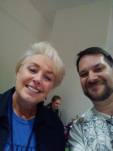
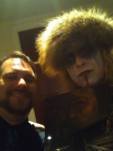
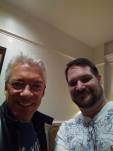
From these guys I learned a lot of information about Audible, about booth displays, about other conventions/bookfestivals, about book covers and book interior layouts. I got new ideas for marketing, book themes and even items to go with the books to draw people to the booth.
By the next convention I hope to have a new book banners, new materials like character bios and character magnets, a new variety of bookmarks based on the books and even (insert drumroll here…) a new book direction – I am going to develop a Steampunk Novel (or novella)! I will still work on my Consequences Within Chaos novel sequel, however, I will be also donating time on a Steampunk storyline. Like I did with In Four Days, be on the lookout for my story blogs!
Why Steampunk? For one, I like the whole western/victorian theme which of course I will beef up with own horror style. Second reason is that this will also give my fans another element or genre that they can delve into with me. And lastly, it is obviously growing in demand and in popularity. I am intrigued just where this could lead me.
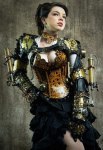


Also I met up with a few voice-over actors that I may be able to help me launch an Audible version of Consequences Within Chaos. Recently, I signed up with Audible and I really love the service. I listen to books now as I do my 3-or-4-mile walk each night. Peter Meredith explained the process to me and really enlightened me on how this could be a big benefit overall to me. We just might see how right he is!
Another great benefit to comic-cons is the artist booths. Not only are their works inspiring and thought-provoking, but they could be great resources in the future. I already have a great artist, Dan Thomas of Dark Art Komics helping me out and showing me the ropes at these comic-cons, but I also met Jacob Spill (https://www.facebook.com/jspill) and several other artists that could help me with illustrations or covers in the future.
Financially I took a gamble, threw the dice and unfortunately hit a wall with Galaxyfest, but I did get a lot out of it in terms of marketing knowledge and trade information. I will certainly do more conventions — JUST DO IT BETTER!
Here are a few more pictures of the fun characters and fans you do run into at these things!
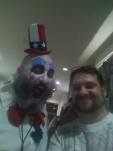
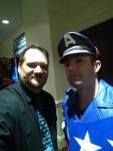
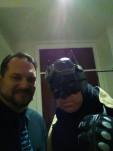
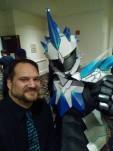
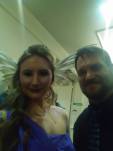
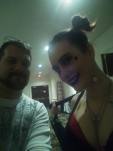
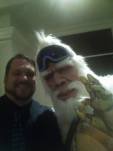


February 21, 2017
New Character Sketch #1…
Behind-the-scenes look at a new character coming up in my new novel, The Bleeding Crown.
This is a rough draft of her background story and her status before the events unfold in the book. (Keep in mind that I may include all or selections of this character sketch. It falls under the option “Author’s Choice”! ha)
Ama’yen of the Yuul
(Actress – Nadine Njeim)
[image error]
Character Profile Questions:
How old? 22 years old
What does the character look like? Ama’yen has smooth, raven hair, tan skin, large feline-type silver eyes. Her race known as the Yuul all have the feline eye features and some have small cat-like ears. She is in prime health and young. However, the Yuul do not live as long as other races and usually have only a lifespan of forty to fifty years.
Where is the character from? The Yuul live on the Island Nation of Fhey Ras, a chain of thick, lush jungles and mountain range islands. Their capital city, Braama thrives in the crater of a dead volcano. Giant Tarro Black Eagles live along the tops of these mountains and have been domesticated by the Yuul.
How does your character deal with conflict? Ama’yen has become a survivalist and pragmatic. She will do whatever is necessary to keep her brothers alive and to complete her missions. Rare to show emotion and rarer to anger. Strong-minded, very rational and focused.
Where does she live? After the execution of her father, the Yuul surrendered to the Quietus Armies. She was forced to become a formidable enforcer for the Ebon Throne. Now as a powerful sorceress, she performs detailed and intricate shadow missions — espionage and capturing enemies or persons of interest. Ama’yen’s younger twin brothers are held as captives which keeps her loyal and devout.
Does the character have any unique or special abilities? Ama’yen can call upon red, lightning elemental spells, but her greatest gift she is born with is the ability to magically clone herself for a temporary period. This allows herself to do multiple tasks all at once — cast several spells or fight hand to hand. She can clone up to four forms of herself that will last up to fifteen minutes or until the clone suffers too much damage. This can only happen two times a day and she suffers crippling fatigue from this endeavor.
Who else is in their life? She leads a small coven of other female Yuul sorcerers called the Rohax. She does have a lover, a female Yuul Beast-Master, Keseli. She trains the Tarro and Ama’yen’s hunting beasts, the Panzurs (pitbull-panthers hybreds). Ama’yen has no intention of any true, long-term romance with Keseli. They flirt and use each other for their needs, but she has no future plans for herself or with anyone.
The character’s status? As a Quietus enforcer, she has done well for herself and is favored with rewards often for her excellent service. Due to her obsessive determination, she rarely makes mistakes or unfulfills her missions. This has earned her many enemies as well as an almost legendary fearsome reputation. She will not be overtly evil or cruel, just business-like and unmoved by any pleas or begging. No one’s life is above her brothers’ lives. Her worry over her brothers keeps her locked in a private mental cell.
What is your character’s goal or motivation? She hopes to one day earn her twin brother’s freedom. She will not allow herself to think past this goal or have hope for a future for herself until then. In her mind, she will always be enslaved to The Bleeding Crown and the tyranny of the Quietus.


February 8, 2017
Wishful Thinking…
[image error]
Tonight I would like to just give you a brief glimpse into my mind and a snapshot image of some of the people from Consequences Within Chaos, my first novel.
As every writer and perhaps every reader will tell you, the characters and the places where they live can become so real, so tangible that when the book ends, you can actually feel a sense of loss. A painful separation from heroes that you cheered for, walked right by their side when they fell or when they made a bad mistake. When the book ends, you lose these new friends. Trust me, the writer feels that same way as the readers.
Well, at least until the author brings them back to you in another story. That is the whole fundamental reason for “sequels” — we miss these people and want to see them succeed at least one more time!
Anyway, I digress.
If I were to make a movie adaption today, who would I pick to play them? Here are my choices for the main characters (heroes and villains) of Wyvernshield:
Prince Taihven Artadeus
Andrew Garfield
[image error]
Prince and Heir-Apparent to the Throne of Tayneva and the capital city of Wyvernshield. He has lived seventeen years in shame and an embarrassment to his royal family due to a hidden mental malady that blurs the lines between reality and fantasy for him.
Princess Letandra Artadeus
Georgie Henley
[image error]
She is older than her brother Taihven and has always been his protector and biggest defender. Often Letandra finds herself in the middle of conflicts between Taihven and his Queen mother, Demetryce.
Queen Demetryce Artadeus
Helen Mirren
[image error]
Queen and Court Justice for Wyvernshield. Her cold demeanor and hard line stance on most subjects has not made her a popular person among the citizenry nor is she a well-respected diplomat like her husband.
King Haedrec Artadeus
J.K. Simmons
[image error]
A legendary ruler and adventurer that resurrected the city of Wyvernshield from ancient ruins. He has always prevailed for his people and his triumphs told often in song and story. However, at the twilight of his life, he is succumbing to the Withering Disease when his city is bracing for a crushing siege by an army of beasts known as the Viestrahl.
Auste Cros’seau
Rutger Hauer
[image error]
Son to an exiled noble that once tried to usurp the Artadeus Throne. The dangerous spellcaster vows to restore all that was taken from his family and expects royal blood to be spilt in the streets of Wyvernshield.
Sergeant Renald Devin
Anthony Anderson
[image error]
A charming warrior and leader among the Wyvernguard. He wants to be instrumental in stopping the Viestrahl once and for all.
Sergeant Deliah Blackstaff
Emily Black
[image error]
Another strong leader within the ranks of the Wyvernguard. Her growing reputation and fighting prowess has paved the way for other females to shine in a male dominant military. She even inspires Princess Letandra to take on more of an active role and face challenges head-on.
Captain Bardun Ruessard
Terrance Stamp
[image error]
Battle-harden veteran responsible for finding answers that will protect the lands of Tayneva while defending against internal citizen unrest and political strife centered around the Artadeus Throne.
Taliah
Isla Fisher
[image error]
A young castle maid forced into a dangerous position that will cost her life, freedom or the country she loves.
LLasher
Nestor Carbonell
[image error]
Contracted for a dark deed, this Camiyaan slaver discovers more than he could have ever bargained for and becomes entwined in the volatile, bloody history that has risen to haunt the Artadeus Throne.
This was an entertaining exercise and a silly fantasy that I thought would be fun to share with you. You may of course have different depictions of these people in your head as you read and that is fine — in fact I would love to hear your thoughts, feedback and/or opinions of who you would like to see as these characters. Let me know!!


January 29, 2017
The Art of the Juggle…
[image error]
“Keep a small can of WD-40 on your desk—away from any open flames—to remind yourself that if you don’t write daily, you will get rusty.”
—George Singleton
“A writer writes.”
Okay… This adage is a very old and a very easy piece of advice to spout, but how does this really guide us? I suppose the practical message means that in some form or some way, you need to get writing done as much as possible. Stop letting the poor excuses or the multiple obstacles get in the way. Like any other craft, as you practice or perform, you will hone your skills and find it gets easier and better.
But, we only have 24 hours each day to get the millions of distractions to ignore, objections to overcome, questions to surpass, phone calls to return, emails to reply, careers to succeed in, family to care for and finally extract a small window of time out of the day for a writer to write (MAYBE) before we collapse into bed.
I have here a few techniques which I have garnered through experience and research and used to find that elusive window of opportunity.
First, take an inventory of your life – a snapshot of your day and then your week. By understanding just what you want to accomplish, what has to be done each day, what is a common issue, then you will be able to spot trends or patterns that you can take advantage of.
Using me for example: I work the late shift as a sales supervisor (the day job) Sunday through Thursday 11:30 to 8 pm (the “has to be done” part). I know myself – I am not a morning person; more of a night owl. I have a large family and a list of household chores like everyone else. I like to write when it’s quiet and I can focus (my “common issue” part).
My routine is thus: During the week — Wake an hour before work, get ready and then rush off (after fitting in a couple chores, Ha!). Then after work, come home, eat dinner, watch maybe an hour of television with the family, then go walk (the “what you want to accomplish” part — I am putting in a nightly effort at walking to reduce my weight). When I get back, the household has settled down and the family has gone to bed.
Now is MY TIME…
Much like my routine for the week, during the weekend my routine is to spend quality time with my loved ones, get the rest of the chores completed, walk after dinner and then write in the evening. That is really all it takes. Track down what you are doing consistently during the week with work and outside of work. Know when you are the most creative/focused and then make that YOUR TIME.
Second, make this a habit and a part of who you are. Invest in yourself, commit to your career and take to heart the idea that you are a writer.
It has become second-nature to me. Not only are you being more productive, the established time let’s everyone know that this is when you are writing. It’s your signal that you are working. Now, if I haven’t actually written that day, I find myself getting restless and I toss-and-turn in bed.
Third, take advantage of even the little windows of time. Some writers have found success by slipping in writing on lunch breaks at work, writing while waiting for the kids coming out of school, writing after dinner before putting the kids to bed. Even two or three fifteen minute blocks combined in a day can really add up. If you don’t need a long period to accomplish a bit of writing or if you don’t need a startup period to get your creative juices flowing, then this might be the best option for you.
Fourth, remove all internet and phone distractions when you write. It’s super easy to “just check on that post” on Facebook or maybe see what Trump said this time on CNN.com. Also if you leave your email up, you will get notifications that will detour you or pull you right out of your writing mode.
Same goes with having your cell phone next to you. It takes only one notification bleep to derail you. Best way to make good use of the little window you may have is to remove all these possible distractions. I only keep one site open that plays classical music in the background – the music helps me focus.
These four steps have really assisted me in understanding what I needed to do and how to find a time to write, market and/or research each and every night.
Hope this helps you! NOW go write, writer!
Write while the heat is in you. … The writer who postpones the recording of his thoughts uses an iron which has cooled to burn a hole with.”
—Henry David Thoreau


January 23, 2017
IN FOUR DAYS: Horror Suspense Novella… Now on Sale!!!
My newest work, In Four Days: Horror Suspense Novella is now on Amazon Books and Kindle!
[image error]
Mysterious disappearances suddenly plague the Philadelphia area. A demonic force with an unending appetite hunts its streets and collects lost souls as trophies.
A young accountant encounters an unrelenting stalker and details her terror upon the internet…
A troubled youth finds that even with new surroundings your troubles can still burn you…
A cab driver with ties to European organized crime soon regrets his own violent actions…
And a pair of brothers with a deep secret plunge into an abyss that threatens to swallow them whole.
IN FOUR DAYS is a collection of chilling stories of intense dread, buried dirty secrets and twisted fates that will leave you guessing up to the very end!
*** Includes bonus short story, SEYDE IN BLOOD (Prequel to Consequences Within Chaos)***
On sale at Amazon Books (In Four Days – Paperback $6.99 only)
On sale at Kindle Books (In Four Days – Ebook Version $1.99 only)
Get your copy now and let me know what you thought of it on Amazon Book Reviews!





